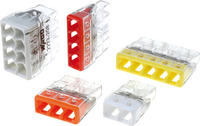Hello.
I am preparing a small modernization of the electrical system in my grandmother's house. Due to the fact that there is an old installation, it is necessary to replace practically everything that is outside the meter.
I have already chosen fuses (from Moeller):
1.16A for sockets (1 room / 4 sockets = 1 fuse + separate kitchen and bathroom), 3x2.5mm2 YDYt cable,
2.10A for lighting (1st floor = 1 fuse), 3x1.5mm2 YDYt / 2x1.5mm2 cable (if there are no clinks),
Now I have a problem of a different nature, because all the time I connected the cables in boxes with twisted pair, additionally soldered and put on heat-shrinkable tubes. Recently, my uncle and I went to the topic of electrical installations and he persuaded me to use wago quick connectors, I knew about them before, but I used them only a few times and only for lighting wiring.
Is it safe to use Wago for socket wiring, if so, what type to use (because Wago has a whole catalog with these connectors)? I am asking because I would have run away much faster with the job and I hesitate because the opinions are divided. The installation must last for years, so that the grandmother would not have problems with her grandson ^^
I am preparing a small modernization of the electrical system in my grandmother's house. Due to the fact that there is an old installation, it is necessary to replace practically everything that is outside the meter.
I have already chosen fuses (from Moeller):
1.16A for sockets (1 room / 4 sockets = 1 fuse + separate kitchen and bathroom), 3x2.5mm2 YDYt cable,
2.10A for lighting (1st floor = 1 fuse), 3x1.5mm2 YDYt / 2x1.5mm2 cable (if there are no clinks),
Now I have a problem of a different nature, because all the time I connected the cables in boxes with twisted pair, additionally soldered and put on heat-shrinkable tubes. Recently, my uncle and I went to the topic of electrical installations and he persuaded me to use wago quick connectors, I knew about them before, but I used them only a few times and only for lighting wiring.
Is it safe to use Wago for socket wiring, if so, what type to use (because Wago has a whole catalog with these connectors)? I am asking because I would have run away much faster with the job and I hesitate because the opinions are divided. The installation must last for years, so that the grandmother would not have problems with her grandson ^^



